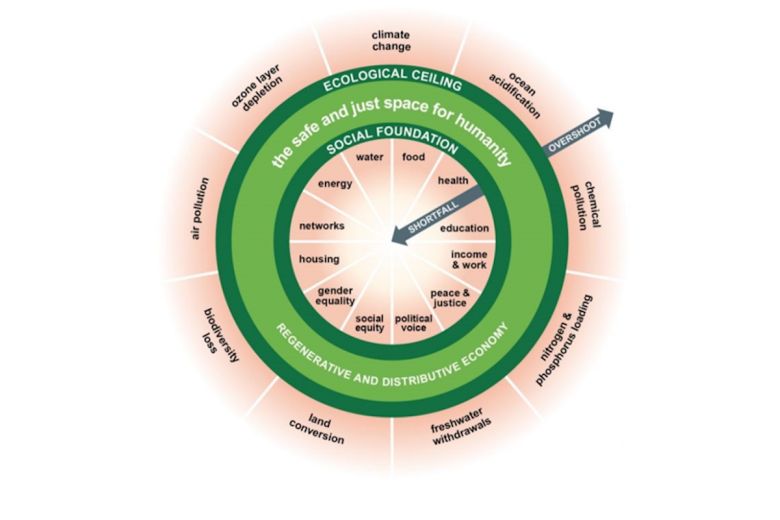Science
Examining the Gaps in Doughnut Economics and Its Proposals

In her book, “Doughnut Economics: Seven Ways to Think Like a 21st-Century Economist,” British researcher Kate Raworth aims to redefine economic paradigms by addressing the limitations of traditional models. Published in March 2017, the book critiques mainstream economic thought while promoting a visual framework—the Doughnut—to represent the balance between environmental sustainability and human prosperity. Despite its ambitions, critics argue that Raworth’s approach may not adequately challenge existing economic models or provide a cohesive alternative.
Raworth’s premise stems from a historical understanding of economics that gained prominence in the 1960s and 1970s. During this time, a mathematical approach to economics emerged, largely built upon the theories of economists such as Paul Samuelson and Ken Arrow. These models depicted the economy as a system of rational agents engaging in market transactions. While initially not associated with libertarian ideologies, in the following decades, their applications grew to support free-market principles, often overlooking complexities that arise in real-world economies.
In response to this intellectual dominance, two distinct groups emerged to critique the prevailing economic theories. The first group sought to reform from within, developing concepts like public goods and behavioral economics. The second group, often labeled “heterodox,” rejected the conventional mathematical models altogether, exploring insights from disciplines like ecology and sociology. This latter group faced a significant challenge: while they identified numerous critiques, they struggled to present a unified alternative framework to replace traditional economic models.
Raworth’s “Doughnut” concept aims to visually encapsulate the trade-off between environmental limits and human needs. The Doughnut diagram illustrates that moving towards the center leads to increased poverty, while extending beyond its outer limits results in environmental degradation. This insight highlights a critical tension between economic growth and ecological sustainability, suggesting a need for balance.
Critics note that Raworth’s representation, while compelling, may not fully transcend established economic frameworks. For instance, mainstream economics already utilizes a similar concept called the production possibilities frontier (PPF), which effectively represents trade-offs between different economic outputs, including environmental considerations. The PPF provides a clear visual tool that captures the complexities of these trade-offs, while Raworth’s Doughnut, despite its engaging presentation, lacks the analytical rigor necessary for predictive economic modeling.
The popularity of Raworth’s work can be partially attributed to the rising interest in the concept of “degrowth,” particularly in regions such as the UK and Northern Europe. While advocating for a reconsideration of GDP as a primary measure of economic success, Raworth acknowledges the essential role of growth in alleviating poverty in developing countries. This recognition positions her argument as a nuanced critique of mainstream economics, albeit one that some argue fails to adequately address the benefits of growth in wealthier nations.
A significant portion of “Doughnut Economics” critiques the inadequacies of GDP as a measure of well-being. While Raworth suggests alternative indices, such as the Human Development Index (HDI), to gauge societal success, these measures often correlate closely with GDP, raising questions about their effectiveness. Critics argue that while income growth is not a panacea for all societal issues, it remains a crucial factor in improving living standards, particularly in poorer countries.
Despite its ambitious intentions, “Doughnut Economics” struggles with coherence and focus. Rather than providing a clear alternative to existing economic theories, the book presents a collection of critiques, many of which are valid yet disconnected from a central framework. Moreover, Raworth’s rejection of traditional predictive economics in favor of a normative approach raises concerns about the practicality of her proposals. Critics contend that economics should retain its analytical capabilities to inform policy decisions and societal planning effectively.
Many of Raworth’s critiques of mainstream economics are grounded in valid observations. However, her work often lacks the depth necessary to engage with the complexities of economic systems genuinely. For instance, her advocacy for state-owned banks and low interest rates overlooks the intricacies of monetary policy and its implications for asset prices. Similarly, her discussions on environmental policies may not fully account for the predictive insights offered by economic models.
In conclusion, while Kate Raworth‘s “Doughnut Economics” presents a thought-provoking perspective on the intersection of environmental sustainability and economic growth, it falls short of delivering a comprehensive alternative to established economic paradigms. The book’s critiques are essential, but its inability to synthesize these into a cohesive framework limits its impact on the ongoing conversation surrounding economic theory and practice. As the field continues to evolve, the challenge remains to integrate valuable insights from both mainstream and heterodox approaches to develop a more inclusive and effective economic model for the future.
-

 World5 months ago
World5 months agoSBI Announces QIP Floor Price at ₹811.05 Per Share
-

 Lifestyle5 months ago
Lifestyle5 months agoCept Unveils ₹3.1 Crore Urban Mobility Plan for Sustainable Growth
-

 Science4 months ago
Science4 months agoNew Blood Group Discovered in South Indian Woman at Rotary Centre
-

 World5 months ago
World5 months agoTorrential Rains Cause Flash Flooding in New York and New Jersey
-

 Top Stories5 months ago
Top Stories5 months agoKonkani Cultural Organisation to Host Pearl Jubilee in Abu Dhabi
-

 Sports4 months ago
Sports4 months agoBroad Advocates for Bowling Change Ahead of Final Test Against India
-

 Science5 months ago
Science5 months agoNothing Headphone 1 Review: A Bold Contender in Audio Design
-

 Top Stories5 months ago
Top Stories5 months agoAir India Crash Investigation Highlights Boeing Fuel Switch Concerns
-

 Business5 months ago
Business5 months agoIndian Stock Market Rebounds: Sensex and Nifty Rise After Four-Day Decline
-

 Sports4 months ago
Sports4 months agoCristian Totti Retires at 19: Pressure of Fame Takes Toll
-

 Politics5 months ago
Politics5 months agoAbandoned Doberman Finds New Home After Journey to Prague
-

 Top Stories5 months ago
Top Stories5 months agoPatna Bank Manager Abhishek Varun Found Dead in Well









